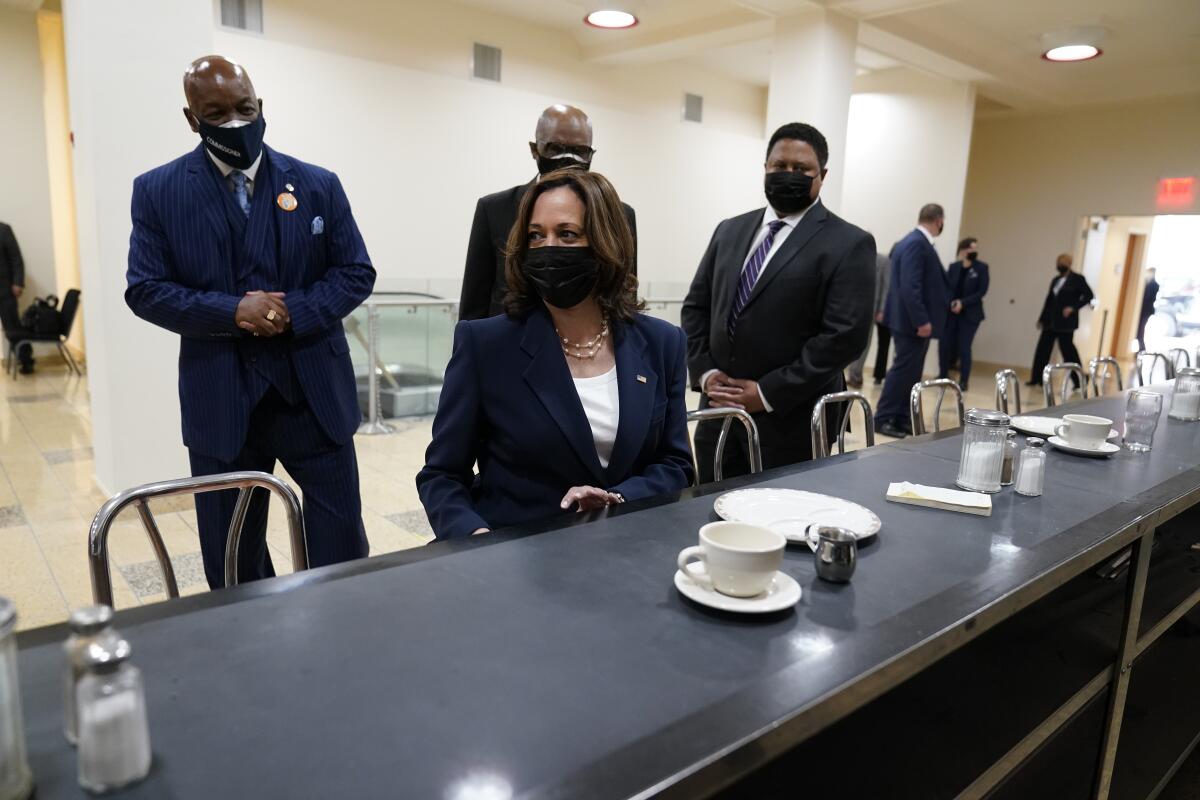Kamala Harris turns road warrior for the Biden infrastructure and jobs plan

- Share via
WASHINGTON — Vice President Kamala Harris traveled to North Carolina on Monday to talk about economic opportunities and electric school buses as part of the Biden administration’s stepped-up efforts to promote its roughly $2-trillion infrastructure, clean energy and jobs spending proposal.
“The American Jobs Plan is not just about fixing what has been,” Harris said. “It’s about building what can be.”
Harris’ advisors portrayed her 15-minute speech at Guilford Technical Community College in Greensboro, N.C., one of her three stops in the state, as her first address on the nation’s economy since she took office, and an opportunity to preview the administration’s message as it nears the 100-day mark. On a factory-style floor surrounded by machines and flags, Harris said the country had administered nearly 200 million COVID-19 vaccine shots, double President Biden’s initial goal, and created a historic number of jobs as the economy begins to rebound from the pandemic’s impact.
“The president and I are ready to keep going and we are not going to take it slow,” she said.
The administration aspires to create “good jobs,” Harris added, defining such jobs as safe, close to home and paying enough to allow Americans to provide for their families without needing a second one. She said the majority of jobs the spending plan would create would not require more than six months of training. The plan would also fund projects to provide safe drinking water, more accessible broadband service and child care, Harris noted.
The trip underscored her role as a top pitch person for the administration’s agenda, even if her role in shaping policy has not yet been clearly defined.
Biden, meanwhile, met at the White House with a small group of lawmakers from both parties, as he has done previously to try to build bipartisan support. His expansive spending plan has yet to draw any Republican support, however. Critics say the bill includes too many Democratic policy initiatives that do not relate directly to roads, bridges and other traditional forms of infrastructure, and Republicans oppose raising taxes on corporations to help pay for the programs.
Harris also made an unannounced stop at the International Civil Rights Center & Museum in Greensboro, built in the former Woolworth’s department store where the sit-in protests of the civil rights movement began after a group of Black students insisted on sitting at the “whites only” lunch counter. Harris, the first woman of color to become vice president, sat in one of the swivel chairs at the former diner as photographers snapped pictures.
Harris also toured an electric school bus plant in High Point, showcasing part of the administration’s infrastructure package that connects with her previous work as a senator. In 2019, then-Sen. Harris introduced a bill to electrify the nation’s school bus fleet.
The infrastructure package includes $20 billion toward converting a fifth of the nation’s 475,000 yellow school buses from diesel to electric, which advocates say will help meet national emissions standards, add manufacturing jobs and better safeguard the health of children. About 95% of the nation’s school buses run on diesel fuel, according to the administration.
The Californian Energy Commission awarded $70 million toward the same purpose in 2019. A 2016 report by the California Air Resources Board estimated that more than 55% of the 25,400 buses were diesel, with only about one-third powered by gas, natural gas, propane, hybrid or electric motors. A 2020 report said only 1% of the fleet, however, was electric.
More to Read
Get the L.A. Times Politics newsletter
Deeply reported insights into legislation, politics and policy from Sacramento, Washington and beyond. In your inbox three times per week.
You may occasionally receive promotional content from the Los Angeles Times.











